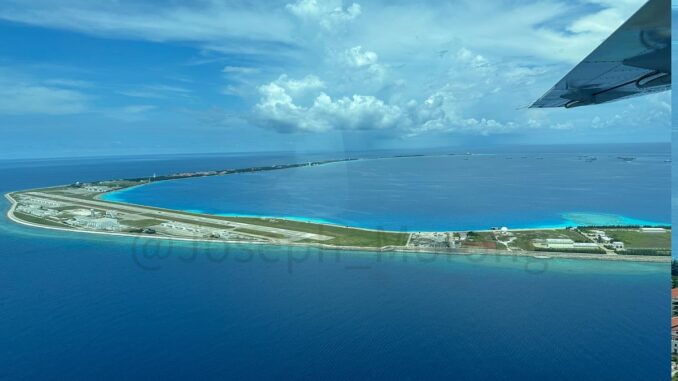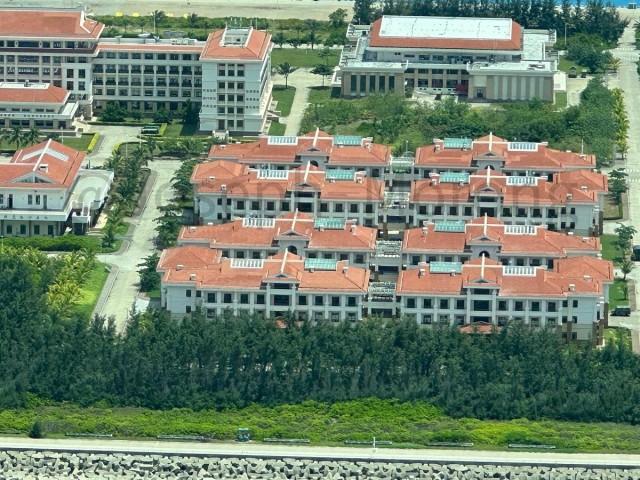
FIRST PERSON ACCOUNT
In Ayungin Shoal, site of a violent clash between Chinese and Philippine forces only in June, is “uncharacteristically” quiet.
From a distance, BRP Sierra Madre, an active Philippine naval post, slowly reveals itself from the window of a Cessna plane of the Bureau of Fisheries and Aquatic Resources (BFAR) on a maritime domain awareness patrol on the West Philippine Sea with the Philippine Coast Guard, August 22.
The ship lies undisturbed with only a handful of Chinese maritime militia vessels standing watch from afar, in the distance a Chinese Coast Guard vessel cuts through the silent waters.
On July 27, the Philippines successfully completed a rotation and resupply mission to the naval post after reaching an agreement with China to de-escalate tensions in the area. No details of the agreement have been revealed to date.
The agreement follows a melee between the Chinese Coast Guard and the Philippine Navy resulting to an injury to a Philippine soldier.
But the tranquility in Ayungin Shoal is belied only by the increasing presence of Chinese maritime militia vessels in Escoda or Sabina Shoal, just east of the shoal and only 75 nautical miles or 140 kilometers west of Palawan.
The maritime patrol shows roughly ten Chinese maritime militia vessels encircling BRP Teresa Magbunua in its immediate vicinity while several others lie in wait. A Chinese hospital ship is spotted as we approached the area.
BRP Teresa Magbunua has been stationed there for four months already following reports that the Chinese have begun reclamation of the atoll.
The Chinese are now accusing the Philippines of semi-grounding the ship similar to what it said the Philippines did in Ayungin Shoal with BRP Sierra Madre, an accusation the Philippine Coast Guard denies.
“China is saying we are going to come up with a forward-base development which they are worried about happening in Escoda. It’s because that’s the way they think. Us, as far as the (Philippine) Coast Guard is concerned, our objective in our deployment in Escoda is to protect the rights of Filipino fishermen,” PCG spokesperson for the West Philippine Sea Commodore Jay Tarriela said.
On August 19, two Philippine Coast Guard vessels were damaged after dangerous maneuvers by the Chinese Coast Guard in the vicinity of Escoda Shoal, a sign that it’s not all peace and quiet in the West Philippine Sea even after the Ayungin agreement.
National Maritime Council spokesperson Vice-Admiral Alexander Lopez sees a 180 degree turn in the Chinese Coast Guard’s behavior.
“You know, the personality of the coast guards, part of their innate functions is safety of life and property at sea among others. Sila mismo ‘yung magpapatupad [They are supposed to implement this] and yet, they are the ones who made the aggressive actions. So ‘di ba, it’s 180 degrees of what they were supposed to do and what we have done in the morning of August 19,” he said.
Lopez said he believes the Ayungin agreement is still useful and said it might extend to other areas in the West Philippine Sea.
“Definitely it is useful because of that understanding that we have with China, it’s just a matter of—kasi iyong understanding din was focused on the RORE missions in Ayungin Shoal. We did not expect that this thing would happen between coast guards. Maybe the scope of the understanding between the two countries, baka – this has been seriously studied by our Department of Foreign Affairs – baka puwedeng ma-extend [maybe it can be extended] in other areas in our maritime domain,” he said.
But Chinese presence in the West Philippine Sea provides a cautionary tale.
In 1995, China seized Panganiban Reef (international name: Mischief Reef) but claimed they were only building a fishermen’s shelter. But this maritime patrol showed a fortified artificial island with countless buildings and military equipment.
We sighted no more than two individuals or at least two vehicles running in Mischief, a virtual ghost town but nonetheless a military post at the ready.
Inside the lagoon, countless numbers of Chinese maritime vessels, with quite a number moored together, a ready advance force that can block Philippine activities in the West Philippine Sea, something Chinas has already displayed in past resupply missions.
In another Chinese held artificial Island, Zamora Reef (international name: Subi Reef), the Chinese shot at at least three flares at the BFAR plane circling the island.
A red burst of light emerged from one of the building after the plane had gone past it before fizzling out and did not reach the plane.
A flare of light that is both a warning and a reminder.
Whether the Ayungin agreement will benefit the Philippines is yet to be known but the future often reveals itself in snippets of the past. — RSJ, GMA Integrated News






Be the first to comment